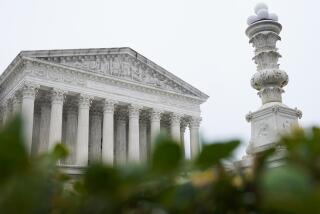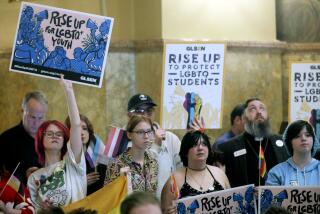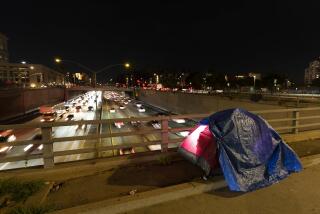Brown vs. Board of Education: Here’s what happened in 1954 courtroom
EDITOR’S NOTE: On May 17, 1954, a hushed crowd of spectators packed the Supreme Court, awaiting word on Brown vs. Board of Education, a combination of five lawsuits brought by the NAACP’s legal arm to challenge racial segregation in public schools. The high court decided unanimously that “separate but equal” education denied black children their constitutional right to equal protection under the law, effectively removing a cornerstone that propped up Jim Crow, or state-sanctioned segregation of the races.
Associated Press reporter Herb Altschull chronicled the decision and what it meant for segregation, which in 1954 permeated many aspects of American life. Using the style and language of journalists of his era, including a reference to Asians as “Orientals,” Altschull captured the uncertainty hanging over a society on the brink of seismic change. Here is Altschull’s compelling report.
The Supreme Court ruled today that the states of the nation do not have the right to separate Negro and white pupils in different public schools.
By a unanimous 9-0 vote, the high court held that such segregation of the races is unconstitutional.
Chief Justice Warren read the historic decision to a packed but hushed gallery of spectators nearly two years after Negro residents of four states and the District of Columbia went before the court to challenge the principle of segregation.
The ruling does not end segregation at once. Further hearings were set for this fall to decide how and when to end the practice of segregation. Thus a lengthy delay is likely before the decision is carried out.
Dean Acheson, secretary of State under former President Harry Truman, was in the courtroom to hear the ruling. He called it “great and statesmanlike.”
Atty. Gen. [Herbert] Brownell was also present. He declined comment immediately. Brownell and the Eisenhower administration, like Truman’s, opposed segregation.
For years 17 Southern and “border” states have imposed compulsory segregation on approximately two-thirds of the nation’s Negroes. Officials of some states already are on record as saying they will close the schools rather than permit them to be operated with Negro and white pupils in the same classrooms.
In its decision, the high court struck down the long-standing “separate but equal” doctrine first laid down by the Supreme Court in 1896 when it maintained that segregation was all right if equal facilities were made available for Negroes and whites.
Here is the heart of today’s decision as it deals with this hotly controverted doctrine:
“We come then to the question presented: Does segregation of children in public schools solely on the basis of race, even though the physical facilities and other ‘tangible’ factors may be equal, deprive the children of the minority group of equal education opportunities?”
“We believe that it does.”
James C. Hagerty, presidential press secretary, told a news conference the White House would have no comment at this time. He noted that Warren’s opinion said formulation of specific decrees must await later hearings.
Gov. Herman Talmadge, one of the most outspoken supporters of segregation, hit back from Atlanta that the court’s decision had reduced the constitution to “a mere scrap of paper.”
“It has blatantly ignored all law and precedent and usurped from the Congress and the people the power to amend the Constitution and from the Congress the authority to make the laws of the land,” Talmadge said.
Thurgood Marshall, Negro attorney from New York who had argued the case against segregation last December, said he was highly pleased that the decision was unanimous and that the language used was unequivocal.
“Once the decision is made public to the South as well as to the North,” Marshall said, “The people will get together for the first time and work this thing out.”
He said he was not in any way fearful lest the final decree nibble away at the principles in the decision. Marshall said, too, he believes the people of the South will abide by the ruling. “The people of the South are just as law abiding as any other good citizens,” he said.
Marshall is a special counsel for the National Association for the Advancement of Colored People, which has spearheaded the drive against segregation. He said NAACP people will meet this week to discuss “what we are going to do.”
Today’s decision was the first major ruling of the Supreme Court since Warren became chief justice last October, succeeding the late Fred Vinson.
The court confined its ruling to the question of the segregation of Negro public school pupils, but it obviously is applicable to the exclusion from public schools of any minority group -- Orientals, Mexicans, Puerto Ricans and so on.
Today’s decision was the latest in a series of court rulings wiping out legal restrictions on Negroes.
In previous cases the Supreme Court had:
1. Ruled that colleges must admit Negroes to study professional courses not open to them in Negro colleges.
2. Ruled that Negroes may not be excluded from train and bus coaches operated in interstate travel.
3. Ruled that Negroes may not be barred from eating in restaurants in the District of Columbia.
The “separate but equal” doctrine was set forth in a 7-1 decision on May 18, 1896, in a case involving Homer Adolph Plessy, who was part Negro.
Plessy boarded a train for a ride from New Orleans to Covington, La., and took a seat in a coach assigned to white passengers in violation of a Louisiana law which required segregation of whites and Negroes on trains.
The conductor asked Plessy to leave the white coach but he refused. A policeman arrested Plessy and took him to jail in New Orleans.
That set off a vigorous legal battle in which the Louisiana Supreme Court eventually upheld the state law. Plessy appealed to the Supreme Court of the United States and the decision went against him.
Justice Henry Billings Brown, who wrote that decision, said the Louisiana law was not in conflict with the U.S. Constitution since Plessy was not refused the right to ride in trains so long as he stayed in a coach restricted to Negroes.
Thus grew up the philosophy of “separate but equal” facilities. Warren, in today’s decision, wrote that the Plessy case involved transportation, not public schools. Inasmuch as he called special attention to the distinction, it is apparent that the court is not now dismissing all forms of segregation.
Warren said that when the 14th Amendment was enacted, “education of Negroes was almost nonexistent, and practically all of the race were illiterate. In fact, any education of Negroes was forbidden by law in some states.”
“Today, in contrast, many Negroes have achieved outstanding success in the arts and sciences as well as in the business and professional world.”
Warren noted that in the early 1870s when cases dealing with segregation first went to the Supreme Court, “compulsory education was virtually unknown” and that for this reason the question of school segregation was unimportant.
After the 1896 decision, Warren wrote, American courts began using it as a basis for decisions on all matters dealing with separation of Negroes and whites.
But it was not until the present cases were brought before the court, Warren said, that the “separate but equal” doctrine was challenged insofar as it might deal with public school education.
Warren noted that the lower courts, in finding against Negro appellants on the basis of the 1896 decision, maintained that the Negro and white schools involved had, in fact, been equalized “with respect to buildings, curricula, qualifications and salaries of teachers and other ‘tangible’ factors.”
But, the Chief Justice said, “our decision. cannot turn on merely a comparison of these tangible factors in the Negro and white schools involved in each of the cases. We must look instead to the effect of segregation itself on public education.”
The Warren opinion recalled that in an earlier decision dealing with the question of whether Negroes should be admitted to graduate courses in segregated universities, the court had said this:
“To separate them (Negroes) from others of similar age and qualifications solely because of their race generates a feeling of inferiority as to their status in the community that may affect their hearts and minds in a way unlikely ever to be undone.”
Reaction from Capitol Hill was swift and in some cases strongly critical.
Sen. [Richard] Russell of Georgia, leader of Southern Democrats in the Senate, termed the decision “a flagrant abuse of judicial power.” He said questions like that of segregation should be decided by the lawmakers, not the courts.
Other Southerners were plainly unhappy, but they did not go so far as Russell. Sen. [Marion Price] Daniel (D-Texas) said the verdict was “disappointing” and that he couldn’t see how the court could arrive at such a decision.
Sen. [Allen J.] Ellender (D-La.) said, “I am of course very much disappointed by this. But I don’t want to criticize the Supreme Court. It is bound to have a very great effect until we readjust ourselves to it.”
He said there would be “violent repercussions” if enforcement were ordered too quickly.
Rep. [Kenneth B.] Keating (R-NY), a strong backer of civil rights legislation, said “There is no doubt about the soundness of the court’s decision.”
Gov. William B. Umstead of North Carolina said in a statement put out by his office that he was “terribly disappointed.”
J.M. Hinton, South Carolina conference president of the National Association for the Advancement of Colored People (NAACP), said:
“Christianity and democracy have been given a great place in America through the elimination of segregation in public school and communism has lost a talking point.”
The appeals from the four states - Kansas, Delaware, Virginia and South Carolina - challenged the legality of segregation on the ground that it violated the 14th Amendment to the Constitution. The District of Columbia complaint alleged violation of the 5th Amendment.
The 14th Amendment, put through shortly after the end of the Civil War, was designed to reinforce the rights of the newly freed slaves. It said that no state may deprive any person of due process or equal rights under the law.
The 5th Amendment gives all persons involved in court cases dealing with federal matters the right to due process of law.
Actually, the court did not decide the question purely on the basis of these amendments.
Warren wrote that the court “cannot turn the clock back” to the enactment of the 14th Amendment in 1868 or the imposing of the “separate but equal” doctrine in 1896.
“We must consider public education,” Warren wrote, “In the light of its full development and its present place in American life throughout the nation. “
“Only in this way can it be determined if segregation in public schools deprives these plaintiffs of the equal protection of the laws.”
“Today, education is perhaps the most important function of state and local governments... It is the very foundation of good citizenship... In these days it is doubtful that any child may reasonably be expected to succeed in life if he is denied the opportunity of an education.”
“Such an opportunity where the state has undertaken to provide it, is a right which must be made available to all on equal terms.”
The court minced no words in applying the “equal rights” section of the 14th Amendment to the issue of school segregation. It said:
“We hold that the plaintiffs and others similarly situated for whom the action has been brought are, by reason of the segregation complained of, deprived of the equal protection of the laws guaranteed by the 14th Amendment.”
It disposed of the “due process” section in this way:
“This disposition makes unnecessary any discussion whether such segregation also violates the due process clause...”
That was for the cases of the four states. But in the District of Columbia case, the court applied the due process provisions of the 5th Amendment, saying:
“We hold that racial segregation in the public schools of the District of Columbia is a denial of the due process of law guaranteed by the 5th Amendment to the Constitution.”
Warren’s opinion noted that enforcement of the court ruling raised “problems of considerable complexity.”
It was for this reason that the court ordered further arguments in the fall. Brownell and the attorneys general of all states where segregation is now permitted were invited to take part, so that appropriate decrees can be worked out.
Briefs must be filed by Oct. 1.
The decision was made public in a highly unusual manner. Normally, copies of Supreme Court rulings are given to reporters simultaneously with the start of their reading from the bench.
In this case, no copies were given out until after Warren had finished reading the opinion. Thus it was not until he was well into it was the full import of the court’s decision known— that segregation had been ruled unconstitutional.
No reason was announced for this departure from the usual practice.
The court had weighed the issues for a long time. The first arguments on the cases were held in December 1952. Rearguments were heard in December 1953, after the Eisenhower Administration took over.
More to Read
Sign up for Essential California
The most important California stories and recommendations in your inbox every morning.
You may occasionally receive promotional content from the Los Angeles Times.










